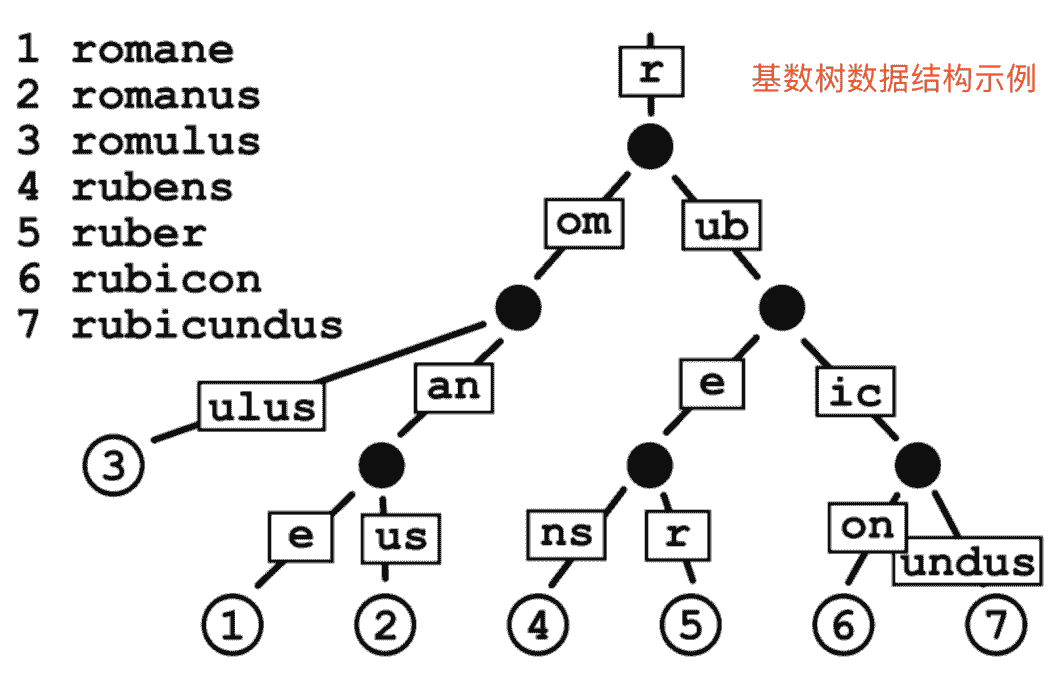路由初使用
# 1.介绍
Gin框架的路由功能是基于httprouter(https://github.com/julienschmidt/httprouter)设计的,httprouter是一由golang实现的路由组件。httprouter使用基数树(也叫基数特里树或压缩前缀树)这种数据结构来维护映射路由关系,通过前缀树快速路由。同时其里面的HttpRouter结构体实现了golang的net.http.server的Handler接口,可以作为httpHandle发布。
基数树(
Radix Tree)又称为PAT位树(Patricia Trie or crit bit tree),是一种更节省空间的前缀树(Trie Tree)。对于基数树的每个节点,如果该节点是唯一的子树的话,就和父节点合并。

# 2.HTTP方法
在Gin框架中对HTTP常见相关方法(GET、POST、PUT、DELETE、HEAD等)已经做了封装,直接调用就会快速注册相关路由,源码所在文件位置:github.com/gin-gonic/gin/routergroup.go
# 2.1 使用示例
main.go 源码(https://github.com/52lu/gin-use/blob/main/main.go)
routing_use.go 源码(https://github.com/52lu/gin-use/blob/main/practise/routing_use.go)
--------------------------- main.go 代码 -------------------------------
package main
import (
"github.com/gin-gonic/gin" // 引入Gin框架
"go-use/practise" //引入使用示例代码包
)
func main() {
// 创建一个默认的路由引擎
engine := gin.Default()
// 调用HTTP方法路由
practise.UseHttp(engine)
_ = engine.Run()
}
----------------------- go-use/practise/routing_use.go代码 -----------------------
// 学习使用HTTP方法
func UseHttp(engine *gin.Engine) {
// 使用Get方法
engine.GET("/get", func(context *gin.Context) {
context.JSON(200,gin.H{"msg":"请求成功","method":"get"})
})
// 使用Post方法
engine.POST("/post", func(context *gin.Context) {
context.JSON(200,gin.H{"msg":"请求成功","method":"post"})
})
// 使用PUT方法
engine.PUT("/put", func(context *gin.Context) {
context.JSON(200,gin.H{"msg":"请求成功","method":"put"})
})
// 使用DELETE方法
engine.DELETE("/del", func(context *gin.Context) {
context.JSON(200,gin.H{"msg":"请求成功","method":"del"})
})
// 使用HEAD方法
engine.HEAD("/head", func(context *gin.Context) {
context.JSON(200,gin.H{"msg":"请求成功","method":"head"})
})
}
2
3
4
5
6
7
8
9
10
11
12
13
14
15
16
17
18
19
20
21
22
23
24
25
26
27
28
29
30
31
32
33
34
35
36
37
启动日志输出:
[GIN-debug] [WARNING] Creating an Engine instance with the Logger and Recovery middleware already attached.
[GIN-debug] [WARNING] Running in "debug" mode. Switch to "release" mode in production.
- using env: export GIN_MODE=release
- using code: gin.SetMode(gin.ReleaseMode)
[GIN-debug] GET /get --> go-use/practise.UseHttp.func1 (3 handlers)
[GIN-debug] POST /post --> go-use/practise.UseHttp.func2 (3 handlers)
[GIN-debug] PUT /put --> go-use/practise.UseHttp.func3 (3 handlers)
[GIN-debug] DELETE /del --> go-use/practise.UseHttp.func4 (3 handlers)
[GIN-debug] HEAD /head --> go-use/practise.UseHttp.func5 (3 handlers)
[GIN-debug] Environment variable PORT is undefined. Using port :8080 by default
[GIN-debug] Listening and serving HTTP on :8080
2
3
4
5
6
7
8
9
10
11
12
13
调用示例:
# GET请求
➜ ~ curl -X GET http://127.0.0.1:8080/get
{"method":"get","msg":"请求成功"}%
# 使用GET请求接收post的路由会报错
➜ ~ curl -X GET http://127.0.0.1:8080/post
404 page not found%
# POST请求
➜ ~ curl -X POST http://127.0.0.1:8080/post
{"method":"post","msg":"请求成功"}%
# PUT 请求
➜ ~ curl -X PUT http://127.0.0.1:8080/put
{"method":"put","msg":"请求成功"}%
# DELETE请求
➜ ~ curl -X DELETE http://127.0.0.1:8080/del
{"method":"del","msg":"请求成功"}%
# HEAD请求
➜ ~ curl -i -X HEAD http://127.0.0.1:8080/head
Warning: Setting custom HTTP method to HEAD with -X/--request may not work the
Warning: way you want. Consider using -I/--head instead.
HTTP/1.1 200 OK
Content-Type: application/json; charset=utf-8
Date: Mon, 26 Apr 2021 08:55:19 GMT
Content-Length: 38
2
3
4
5
6
7
8
9
10
11
12
13
14
15
16
17
18
19
20
21
22
23
需要注意的是:当路由注册成指定HTTP方法时,必须以同样的方式请求,否则会返回:
404 page not found
# 2.2 匹配所有HTTP请求
使用Any方法,可以匹配所有的HTTP的方法(GET, POST, PUT, PATCH, HEAD, OPTIONS, DELETE, CONNECT, TRACE)
使用示例如下:
func main() {
// 创建一个默认的路由引擎
engine := gin.Default()
// 匹配HTTP方法方法
engine.Any("/all", func(context *gin.Context) {
context.JSON(200,gin.H{"msg":"success"})
})
_ = engine.Run()
}
2
3
4
5
6
7
8
9
# 3.注册规则
# 3.1 定义
根据上面示例,可以总结注册HTTP方法路由时,规则如下:
// engine := gin.Default()
engine.MethodName(path string, ...HandlerFunc)
2
path: 代表的是路径...HandlerFunc: 一个或多个接收请求的处理函数。
# 3.2 传多个HandlerFunc示例
package main
import (
"github.com/gin-gonic/gin" // 引入Gin框架
)
func main() {
// 创建一个默认的路由引擎
engine := gin.Default()
// 注册路由,接收两个HandlerFunc
engine.GET("/handler",handFuncA,handFuncB)
_ = engine.Run()
}
func handFuncA(ctx *gin.Context) {
ctx.JSON(200, gin.H{"msg": "handFuncA"})
}
func handFuncB(ctx *gin.Context) {
ctx.JSON(200, gin.H{"msg": "handFuncB"})
}
2
3
4
5
6
7
8
9
10
11
12
13
14
15
16
17
请求输出:
➜ curl -X GET http://127.0.0.1:8080/handler
{"msg":"handFuncA"}{"msg":"handFuncB"}
2
# 4.匹配规则
由于Gin路由采用的是httprouter,而httprouter的路径匹配规则整理如下
# 4.1 /path
这类路径只会匹配/path,@@注意:不会匹配/path/。
a. 启动服务
func main() { // 创建一个默认的路由引擎 engine := gin.Default() // 注册路由 engine.GET("/test", func(context *gin.Context) { context.JSON(200, gin.H{ "msg": "success", }) return }) _ = engine.Run() }1
2
3
4
5
6
7
8
9
10
11
12b. 发起请求
# 会匹配 ➜ curl -X GET http://127.0.0.1:8080/test {"msg":"success"} # 命令行请求返回,用浏览器请求会正常返回 ➜ ~ curl -X GET http://127.0.0.1:8080/test/ <a href="/test">Moved Permanently</a>1
2
3
4
5
6@注意
当注册路由路径是:
/path时,不会匹配/path/,用命令请求则返回<a href="/test">Moved Permanently</a>,但是用浏览器请求则会正常返回。原因:httprouter默认开启自动重定向,/path/会被重定向到/path,如下图所示:
# 4.2 :param
:param: 都是参数的名称
a. 匹配规则
路由规则 请求示例 参数值 /path/:a /test/张三 a=张三 /path/:a/:b /test/张三/1 a=张三,b=1 /path/:a/:b/:c /test/张三/1/2 a=张三,b=1,c=2 b. 启动服务
package main import ( "github.com/gin-gonic/gin" // 引入Gin框架 ) func main() { // 创建一个默认的路由引擎 engine := gin.Default() // 注册路由 engine.GET("/test/:name", func(context *gin.Context) { // 接收参数 name := context.Param("name") context.JSON(200, gin.H{"msg": "success", "name": name}) }) engine.GET("/test/:name/:age", func(context *gin.Context) { // 接收参数 name := context.Param("name") age := context.Param("age") context.JSON(200, gin.H{ "msg": "success", "name": name, "phone":age, }) }) engine.GET("/test/:name/:age/:height", func(context *gin.Context) { // 接收参数 name := context.Param("name") age := context.Param("age") height := context.Param("height") context.JSON(200, gin.H{ "msg": "success", "name": name, "phone":age, "height":height, }) }) _ = engine.Run() }1
2
3
4
5
6
7
8
9
10
11
12
13
14
15
16
17
18
19
20
21
22
23
24
25
26
27
28
29
30
31
32
33
34
35
36
37c. 发起请求
➜ curl -X GET http://127.0.0.1:8080/test/张三 {"msg":"success","name":"张三"} ➜ curl -X GET http://127.0.0.1:8080/test/张三/18 {"msg":"success","name":"张三","phone":"18"} ➜ curl -X GET http://127.0.0.1:8080/test/张三/18/170 {"height":"170","msg":"success","name":"张三","phone":"18"}1
2
3
4
5
6
# 4.3 *param
从指定位置开始 (包含前缀
"/") 匹配到结尾。
a. 匹配规则
路由规则 请求示例 参数值 /path/*a /test/张三 a=/张三 /test/张三/1 a=张三/1 /test/张三/1/2 a=张三/1/2 b.启动服务
package main import ( "github.com/gin-gonic/gin" // 引入Gin框架 ) func main() { // 创建一个默认的路由引擎 engine := gin.Default() // 注册路由 engine.GET("/test/*param", func(context *gin.Context) { // 接收参数 param := context.Param("param") context.JSON(200, gin.H{"msg": "success", "name": param}) }) _ = engine.Run() }1
2
3
4
5
6
7
8
9
10
11
12
13
14
15c. 发起请求
➜ curl -X GET http://127.0.0.1:8080/test/张三 {"msg":"success","name":"/张三"} ➜ curl -X GET http://127.0.0.1:8080/test/张三/1 {"msg":"success","name":"/张三/1"} ➜ curl -X GET http://127.0.0.1:8080/test/张三/1/2 {"msg":"success","name":"/张三/1/2"}1
2
3
4
5
6